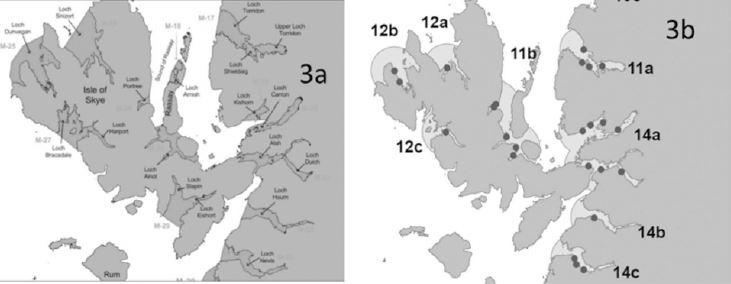Aquaculture zones
Aquaculture is absent from large zones of the Scottish coastal environment. There is a policy presumption against further marine finfish farm development on the north and east coasts Thus a very large proportion of the Scottish coast remains undeveloped. This area includes the mouths of most of the rivers with larger populations of wild salmon, such as the Tweed, the Dee and the Spey.
Aquaculture is excluded from other zones for purposes such as shipping, naval activity, offshore energy production and conservation purposes.

Figure 3. 3a. Example of Farm Management Areas (FMAs) and 3b. Disease Management Areas (DMAs) maps in the area of the Isle of Skye, west coast of Scotland. FMAs and DMAs are generally similar, but differ in detail (e.g., FMAs M-19, M-20 and M-21 are all in DMA 14a).
Within the areas where aquaculture is practiced (the west coast, the Western Isles, Orkney and Shetland) farms are grouped into areas of interaction. There are three such areas designed for different purposes.
These are Farm Management Areas, Disease Management Areas and ’Categorised’ inshore water bodies (mostly sea lochs) in the ‘Locational Guidelines for Marine Fish Farming’ (Figure 3, Figure 4).
Farm management areas (FMAs) are groups of farms whose interaction requires collaboration (Figure 3a).
The FMA boundaries are defined by industry on the basis of local knowledge and practicalities, although Scottish Ministers reserve the power to revise these boundaries. Boundaries do change with experience, for example FMAs in southeast Shetland were amalgamated after ISA spread across the FMA boundaries. The boundaries are shown in the Code of Good Practice4
4 http://thecodeofgoodpractice.co.uk/
and farms within such areas require a Farm Management Agreement (FMAg) or a Farm Management Statement (FMS) that specifies their activities under the Aquaculture and Fisheries Act (Scotland) 2013; many FMAs existed on a voluntary basis, sometimes for many years, before the passing of the Act. There are currently 89 FMAs in Scotland.
Disease Management Areas (DMAs) are used for the control of notifiable diseases (Figure 3b),5
5 www.scotland.gov.uk/Topics/marine/Fish-Shellfish/FHI/managementagreement
particularly Infectious Salmon Anaemia (ISA). These DMAs were developed during a severe ISA outbreak in 1998/9 and were used to contain and eventually eradicate this. The boundaries are defined using an epidemiologically significant distance, (3.629 km in Shetland and 7.258 km elsewhere in Scotland), around each farm. Where these circles overlap, farms are included within the same DMA, which stretches until a separation of twice the circle radius is encountered. These boundaries are thus easily and explicitly defined and establishment of new farms in areas that would join existing DMAs is contrary to Scottish government policy. There currently are 52 DMAs in Scotland.
Sea lochs are defined geographically. These are small fjordic inlets along the Scottish coast that have been systematically catalogued and described by oceanographers since the 1970s. Information on the volume and

Figure 4. Spatial planning policy for aquaculture as laid out in the National Marine Plan. Finfish aquaculture is excluded on the North and East coasts. Inshore water bodies on the West coasts and islands are categorised according to their capacity potential to accommodate more finfish aquaculture.
turnover time of the waters in these lochs, together with biological models of fish metabolism, are used to categorise sea lochs into categories 1, 2 or 3, dependent on how much environmental stress the sea loch is subjected to. This status informs these areas’ suitability for further aquaculture development.